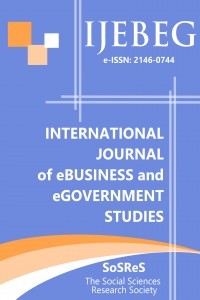DIGITAL DIVIDE AMONG ENTERPRISES IN A DEVELOPING COUNTRY
DIGITAL DIVIDE AMONG ENTERPRISES IN A DEVELOPING COUNTRY
digital divide enterprises, developing countries, Turkey,
___
- Ahmed, Allam (2007), “Open access towards bridging the digital divide–policies and strategies for developing countries”, Information Technology for Development, 13(4), 337-361.
- Al-Hawari, M., H. Al-Yamani and B. Izwawa (2008). “Small Businesses' Decision to have a
- Website Saudi Arabia Case Study”, World Academy of Science, Engineering and Technology, Vol. , pp.308-312. Al-Qirim, Nabeel A. (2007), “E-Commerce Adoption in Small Businesses: Cases from New
- Zealand”, Journal of Information Technology Case and Application Research, Vol. 9, No. 2, pp.28-57. Arendt, Lukasz (2008), “Barriers to ICT adoption in SMEs: How to bridge the digital divide?”,
- Journal of Systems and Information Technology, Vol. 10, No. 2, pp.93-108. Boje, Carmen and Nicolae-George Dragulanescu (2003), “"Digital Divide" in Eastern European countries and its social impact”, Proceedings of the 2003 American Society for Engineering
- Education Annual Conference & Exposition, http://soa.asee.org/paper/conference/paper- view.cfm?id=18355 [Accessed October 9, 2010]
- Chang, She-I, Hsu-Che Wu and Chih-Ming Cho (2011), “The Development of Digital Divide
- Assessment Mechanism for SMEs: A Perspective from the Taiwan Manufacturing Industry”, Journal of Global Information Technology Management, Vol. 14, No. 1, pp.6-34. Chen, Wenhong and Barry Wellman (2004), “The global digital divide-Within and between countries”, IT&Society, Vol. 1, No. 7, pp.39-45.
- Friedman, William H. (2001), “The digital divide”, Prooceeding of Seventh Americas Conference on Information Systems, pp.2081-2086.
- Fuchs, Christian and EvaHorak (2007), “Informational capitalism and the digital divide in Africa”,
- Masaryk University of Law and Technology, Vol. 1, No. 2, pp.11-32. Genus, Audley and Mohd Ali Mohamad Nor (2007), “Bridging the digital divide in Malaysia: An empirical analysis of technological transformation and implications for e-development”, Asia
- Pacific Business Review, Vol. 13, No. 1, pp.95-112. Iskandarani, Mahmoud Z. (2008), “Effect of Information and communication technologies (ICT) on non-industrial countries-digital divide model”, Journal of Computer Science, Vol. 4, No. 4, pp.315-319.
- ITU, (2010), Key ICT indicators, 2005-2010, http://www.itu.int/ITU
- D/ict/statistics/at_glance/KeyTelecom.html [Accessed November 09, 2010]
- Jin, Jianbin and Angus Weng Hin Cheong (2008), “Measuring digital divide: The exploration in
- Macao”, Observatorio (OBS*) Journal, Vol. 6, pp. 259-272. Karanasios, Stan (2007), “Ecuador, the Digital Divide and Small Tourism Enterprises”, Journal of
- Business Systems, Governance and Ethics, Vol. 2, No. 3, pp. 21-34. Lei, Weizhen, Martin R. Gibbs, Shanton Chang and Heejin Lee (2008), “Rethinking the digital divide”, The Proceedings of 19th Australasian Conference on Information Systems, Australia, pp. 550. http://www.bsec.canterbury.ac.nz/acis2008/Papers/acis-0175-2008.pdf [Accessed July , 2010]
- Norris, Pippa (2000), The worldwide digital divide: Information poverty, the Internet and development, http://www.hks.harvard.edu/fs/pnorris/Acrobat/psa2000dig.pdf [Accessed October 8,
- OECD (Organisation for Economic Co-operation and Development) (2001), Understanding the digital divide, http://www.oecd.org/dataoecd/38/57/1888451.pdf [Accessed October 9, 2010]
- Sciadas, George (2005), “Infostates across countries and over time: Conceptualization, modeling, and measurements of the digital divide”, Information Technology for Development, Vol. 11, No. 3, pp.299-304.
- Shih, Eric, Kenneth L Kraemer and Jason Dedrick (2008), “IT diffusion in developing countries”,
- Communications of the ACM, Vol. 51, No.2, pp.43-48. Suchak, Neha and Doug Eisengrein (2008), “Bridging the digital divide: Connecting social marketers globally”, Social Marketing Quarterly, Vol. 14, No. 3, pp. 135-138.
- TurkStat, (2011), ICT Usage Statistics, http://www.tuik.gov.tr/VeriBilgi.do?tb_id=60&ust_id=2 Accessed January 4, 2010]
- Van Dijk, Jan and Kenneth Hacker (2003), “The digital divide as a complex and dynamic phenomenon”, The Information Society, Vol. 19, No. 4, pp. 315-326.
- Yuguchi, Kiyotaka (2008), “The digital divide problem: An economic interpretation of the Japanese experience”, Telecommunications Policy, Vol. 32, pp. 340-348.
- Wilson, Ernest J. (2004), The information revolution and developing countries, Cambridge, MA: MIT Press.
- Zaidi, Mosharraf (2003), “Exploring the depth and breadth of the digital divide in developing countries: The case of Pakistan”, Canadian Association for Information Science (CAIS) 2003
- Conference: Bridging the Digital Divide: Equalizing Access to Information and Communication Technologies, Dalhousie University, Halifax, Nova Scotia, Canada, http://www.cais- acsi.ca/proceedings/2003/zaidi_2003.pdf [Accessed October 8, 2010]
- Wielicki, Tom and Gustavo Cavalcanti (2006), “Study of Digital Divide: Measuring ICT
- Utilization and Implementation Barriers Among SMEs of Central California”, 9th International Conference on Business Information Systems, BIS 2006, Klagenfurt, Austria, pp. 277-294.
- Başlangıç: 2009
- Yayıncı: Sosyal Bilimler Araştırmaları Derneği
DIGITAL DIVIDE AMONG ENTERPRISES IN A DEVELOPING COUNTRY
Ali ACILAR, Gözde KOCA, Çağlar KARAMAŞA
INTERNET MARKETING IN THE PUBLIC SECTOR: THE CASE OF INVESTMENT PROMOTION AGENCIES
İddi MAKOMBE, Muhajir KACHWAMBA
SOPHISTICATION OF E-SERVICES IN TURKISH PROVINCIAL MUNICIPALITIES: RECENT STATUS
Fazli YİLDİRİM, Gonca TELLİ YAMAMOTO
WOMEN EXCLUDED OR EMPOWERED? A CASE FOR DIGITAL LOCAL AGENDA IN EUROPE
DOES INFORMATION TECHNOLOGY CAPABILITY IMPROVE BANK PERFORMANCE? EVIDENCE FROM TURKEY
THE EFFECTS OF E-COMMERCE ON SUPPLY CHAIN IN TURKEY
